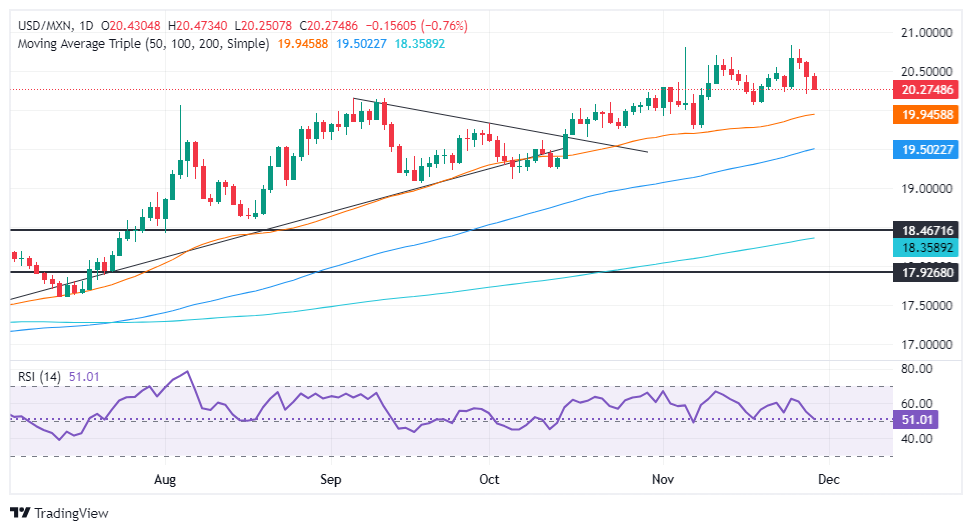- Mexican Peso appreciates 0.59% against US Dollar, poised for strong weekly performance.
- Banxico minutes suggest potential for 50 bps rate cut in December, boosting Peso's outlook.
- President Sheinbaum optimistic about averting Trump's proposed 25% tariffs, bolstering MXN stability.
The Mexican Peso appreciated against the US Dollar during the North American session as the Greenback extended its downfall and is about to hit its most significant weekly loss in three months. Speculation that US President-elect Donald Trump may moderate his trade rhetoric weighed on the American currency. Therefore, the USD/MXN trades at 20.29, down 0.59%.
Mexico’s economic docket was light on Friday, but the Bank of Mexico (Banxico) revealed its November 14 monetary policy meeting minutes on Thursday.
Banxico’s board members voted unanimously to lower rates, and according to the minutes, members agreed that the rate cut cycle “should continue.” Nevertheless, one of the officials suggested “a larger rate adjustment” at the December meeting in light of expectations that core inflation would continue to trend lower.
Even though this opens the door for a 50 bps rate cut at the next meeting, the USD/MXN trended lower after Mexican President Claudia Sheinbaum and US President-elect Donald Trump sustained conversations on Wednesday, calming fears and underpinning the emerging market currency.
Earlier on Friday, President Sheinbaum said she is convinced that she would reach a deal with the US to avoid President-elect Trump's threat of 25% tariffs, according to Bloomberg. She added, “I’m convinced we’re going to reach an agreement while defending our sovereignty, with respect for Mexicans and respect for Mexico, with the collaboration that one government should have with another.”
Meanwhile, US data suggests the economy might be slowing faster than expected. Earlier, the Chicago Purchasing Managers Index (PMI) for November tumbled. It was the second monthly decline from September levels.
Daily digest market movers: Mexican Peso appreciates during the week
- Banxico’s board members noted that the Mexican Peso traded broadly, depreciating markedly and exhibiting volatility mainly due to uncertainty about the US election.
- They added that inflation risks are tilted to the upside, mentioning a greater exchange rate depreciation. They acknowledged the inflation outlook still calls for a generally restrictive policy stance.
- Banxico’s members “agreed that Mexico's inflation outlook has been improving, after the significant global shocks of previous years. However, they forewarned that it still faces challenges.”
- In the bank's quarterly report, Banxico Governor Victoria Rodriguez commented that they monitored the recent Peso volatility and added that there has not been a need to intervene in the forex market.
- The quarterly report revealed that Banxico updated its projection for the Mexican economy to grow 1.8% in 2024, up from 1.5%. Nevertheless, the central bank kept its 2025 Gross Domestic Product (GDP) projection at 1.2%.
- The CME FedWatch Tool suggests that investors see a 66% chance of a 25-basis-point (bps) rate cut at the Federal Reserve’s December meeting, up from 59% a day ago.
- Data from the Chicago Board of Trade, via the December Fed funds rate futures contract, shows investors estimate 24 bps of Fed easing by the end of 2024.
Technical outlook: Mexican Peso recovers as USD/MXN falls below 20.40
The USD/MXN remains upwardly biased despite being set to finish the week with losses. Nevertheless, the pair carved a successive series of higher highs and higher lows, suggesting buyers are in charge. If buyers keep the exchange rate above the November 19 swing low of 20.06, this could pave the way for further upside.
The first resistance would be 20.50, followed by the year-to-date (YTD) peak at 20.82. If surpassed, the next stop would be 21.00, ahead of March 8, 2022 peak at 21.46, followed by the November 26, 2021 high at 22.15.
Conversely, if bears drag the exchange rate below 20.06, the next support would be 20.00. On further weakness, bears could challenge the 50-day Simple Moving Average (SMA) at 19.92. Key support levels lie beneath the latter with the 100-day SMA at 19.48 before the psychological 19.00 figure.
Mexican Peso FAQs
The Mexican Peso (MXN) is the most traded currency among its Latin American peers. Its value is broadly determined by the performance of the Mexican economy, the country’s central bank’s policy, the amount of foreign investment in the country and even the levels of remittances sent by Mexicans who live abroad, particularly in the United States. Geopolitical trends can also move MXN: for example, the process of nearshoring – or the decision by some firms to relocate manufacturing capacity and supply chains closer to their home countries – is also seen as a catalyst for the Mexican currency as the country is considered a key manufacturing hub in the American continent. Another catalyst for MXN is Oil prices as Mexico is a key exporter of the commodity.
The main objective of Mexico’s central bank, also known as Banxico, is to maintain inflation at low and stable levels (at or close to its target of 3%, the midpoint in a tolerance band of between 2% and 4%). To this end, the bank sets an appropriate level of interest rates. When inflation is too high, Banxico will attempt to tame it by raising interest rates, making it more expensive for households and businesses to borrow money, thus cooling demand and the overall economy. Higher interest rates are generally positive for the Mexican Peso (MXN) as they lead to higher yields, making the country a more attractive place for investors. On the contrary, lower interest rates tend to weaken MXN.
Macroeconomic data releases are key to assess the state of the economy and can have an impact on the Mexican Peso (MXN) valuation. A strong Mexican economy, based on high economic growth, low unemployment and high confidence is good for MXN. Not only does it attract more foreign investment but it may encourage the Bank of Mexico (Banxico) to increase interest rates, particularly if this strength comes together with elevated inflation. However, if economic data is weak, MXN is likely to depreciate.
As an emerging-market currency, the Mexican Peso (MXN) tends to strive during risk-on periods, or when investors perceive that broader market risks are low and thus are eager to engage with investments that carry a higher risk. Conversely, MXN tends to weaken at times of market turbulence or economic uncertainty as investors tend to sell higher-risk assets and flee to the more-stable safe havens.
Information on these pages contains forward-looking statements that involve risks and uncertainties. Markets and instruments profiled on this page are for informational purposes only and should not in any way come across as a recommendation to buy or sell in these assets. You should do your own thorough research before making any investment decisions. FXStreet does not in any way guarantee that this information is free from mistakes, errors, or material misstatements. It also does not guarantee that this information is of a timely nature. Investing in Open Markets involves a great deal of risk, including the loss of all or a portion of your investment, as well as emotional distress. All risks, losses and costs associated with investing, including total loss of principal, are your responsibility. The views and opinions expressed in this article are those of the authors and do not necessarily reflect the official policy or position of FXStreet nor its advertisers. The author will not be held responsible for information that is found at the end of links posted on this page.
If not otherwise explicitly mentioned in the body of the article, at the time of writing, the author has no position in any stock mentioned in this article and no business relationship with any company mentioned. The author has not received compensation for writing this article, other than from FXStreet.
FXStreet and the author do not provide personalized recommendations. The author makes no representations as to the accuracy, completeness, or suitability of this information. FXStreet and the author will not be liable for any errors, omissions or any losses, injuries or damages arising from this information and its display or use. Errors and omissions excepted.
The author and FXStreet are not registered investment advisors and nothing in this article is intended to be investment advice.
Recommended content
Editors’ Picks

EUR/USD regains traction above 1.1000 ahead of US CPI release
EUR/USD has found fresh buyers and jumps above 1.1000 in the European session on Thursday. The pair gains on the German coalition deal and Trump's 90-day pause on reciprocal tariffs, which have lifted risk senitment while exacerbating the US Dollar pain ahead of the US CPI data release.

GBP/USD trades firm above 1.2850, US CPI data awaited
GBP/USD sustains the rebound above 1.2850 in European trading hours on Thursday. The British Pound capitalizes on risk appetite, courtesy of Trump's tariff pause, allowing the pair to recover ground. But further upside hinges on the US CPI data and US-Sino trade updates.

Gold price enters hotspot region with new all-time high possible
Gold price is delivering a jaw-breaking performance this Thursday in the early trading session, moving around $3,107 at the time of writing. Since Tuesday morning, the precious metal has rallied nearly 5.00%. The main driver for the rally came from the United States President Donald Trump who announced a 90-day pause to higher tariffs on 56 countries and the European Union, which will now be taxed at the 10% baseline rate.

US CPI data set to reveal March inflation dip as markets weigh impact of Trump’s tariffs
As measured by the CPI, inflation in the US is set to rise at an annual pace of 2.6% in March, down slightly from the 2.8% reported in February. Core CPI inflation, which excludes the volatile food and energy categories, is expected to ease to 3% in the same period from a year earlier

Trump’s tariff pause sparks rally – What comes next?
Markets staged a dramatic reversal Wednesday, led by a 12% surge in the Nasdaq and strong gains across major indices, following President Trump’s unexpected decision to pause tariff escalation for non-retaliating trade partners.

The Best brokers to trade EUR/USD
SPONSORED Discover the top brokers for trading EUR/USD in 2025. Our list features brokers with competitive spreads, fast execution, and powerful platforms. Whether you're a beginner or an expert, find the right partner to navigate the dynamic Forex market.




